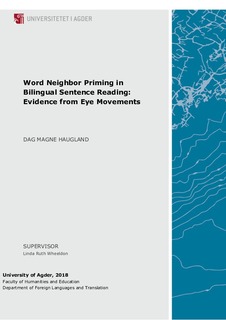| dc.description.abstract | This study investigates English sentence reading processes in Norwegian-English bilinguals.
It aims to explore the effects of word form overlap and its connection to second-language (L2)
English proficiency. We recorded eye movements of Norwegian-English bilinguals while they
read single sentences on screen. The experiment was a replication of Frisson, Koole, Hughes,
Olson and Wheeldon, (2014), who investigated the effects of form similarity between words
(orthographic and phonological, both separate and combined) on sentence reading in English
monolinguals. They also investigated the effects of distance between prime and target words,
and found that words that overlap in both orthography and phonology cause inhibition (longer
gaze durations) when the distance between prime and target was 3 words. Interestingly only
skilled readers showed the same effect when distance between prime and target was 9 words.
Our study aimed to investigate whether the same inhibitory effects occur in Norwegian-
English bilinguals and to determine if aspects of L2 proficiency modulated the effect.
In our experiment, the sentences contained a prime word (related) or matched control word
(unrelated) and a target word. In the related conditions, the prime and target overlapped both
orthographically and phonetically in the end (e.g. fork-pork) or the beginning (e.g. rail-raid).
We also examined the effects of distance between prime and target. In order to investigate
effects of individual differences in bilingual language profile and proficiency, the results were
then correlated with factors of a bilingual profile established using data from a revised LEAPQuestionnaire
from a sister project.
We found that proficient L2 users show more inhibition when there is phonological and
orthographic overlap. Generally, there is inhibition in end overlap items, and facilitation in
begin overlap items, but only when the distance is about 3 words. When prime and target is
separated by 9 words, the effect disappears. We also found that there is a significant
correlation between L2 proficiency and the effects of overlap. The more proficient the
bilingual is in their L2, the more native-like the inhibition effects. We conclude that proficient
L2 readers are more likely to be affected by word overlap priming, and that skilled L2 readers
are negatively impacted by word overlap to a higher degree than less skilled L2 readers are.
These findings suggest that, similar to L1 readers, skilled L2 readers maintain word-form
information for longer when reading than less skilled readers. | nb_NO |

